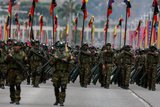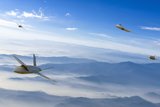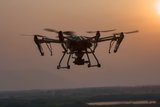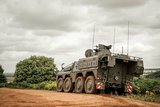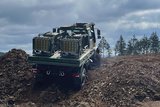The “get everything” sensors are going everywhere (sponsored)
It was a recording that saved lives.
A few years back, a U.S. commander in Afghanistan planning a raid on a suspected Taliban base tasked a powerful wide-area motion imagery (WAMI) sensor called Kestrel to first conduct aerial reconnaissance of his target. In its sweep of the area, Kestrel noted a truck parked at the very entrance of the hideout.
What was on the truck? The commander wondered. And why was it there? Keeping an eye on the hideout in real time, he had the WAMI system replay, in a separate viewer window, archived EO/IR imagery that had been collected over the past few days.
Kestrel, thanks to its vast coverage area (100 square kilometers), was able to rewind and track the suspicious vehicle back in time to a warehouse on the other side of town—something that would have been impossible to do with narrow-field, full-motion video (FMV) cameras.
The warehouse, and the recorded activity around it, showed all the signs of an insurgent bombmaking operation. Armed now with this crucial intelligence, the commander concluded that the parked truck was an explosive-laden boobytrap and, as a result, switched his approach, avoiding the deadly ambush.
The incident with the U.S. commander and the truck was not a one-off. In Afghanistan, Iraq, and other places around the world, WAMI systems have proven themselves to be a superior ISR modality—one currently spreading to a variety of airborne platforms and mission sets.
When they first deployed in the mid-to-late 2000s, the original WAMI systems were massive beasts, weighing some 1500 pounds and mounted in the rear of aircraft such as the Short 360-300s. These systems didn’t yet have an infrared capability and couldn’t stream video down to users on the ground. Still, they were effective at breaking up the insurgent networks emplacing IEDs.
By 2011-2012, WAMI sensors were reduced in size, with Logos Technologies developing Kestrel, a system light enough to be carried by an aerostat flying above a forward operating base. Kestrel could image both day and night, recording what it saw for 30 days at a stretch.
Since no one person could follow all that, the system was configured to transmit multiple unique video “chipouts,” or selections, to the users on the ground. It also allowed users to create tripwire-like “watchboxes,” which activate an alarm when triggered by movement.
Since Kestrel, WAMI systems have only gotten smaller. The current generation Kestrel Block II, for example, shares all these capabilities of its predecessor but is nearly half the weight. This allows the Block II to be mounted on smaller aerostats or share “real estate” with more sensors on a larger aerostat. In addition, the newer WAMI sensor is exportable to international customers.
Sharing real estate is key since, in general, a WAMI system has a 0.5 meter ground sample distance (GSD). This is a good enough resolution for detecting and tracking hundreds of far-flung vehicles and dismounts moving over a city-sized area. But should the user require a closer look, the WAMI system will need to cue an FMV camera to zero in on the target.
In a similar fashion to Kestrel Block II, Logos Technologies has also developed a family of ultra-light systems that can go on a variety of dynamic airborne platforms, from small planes to helicopters, to tactical unmanned aircraft systems (UAS).
Insitu Integrator
One such sensor, Redkite-I, weighs less than 25 pounds and is small enough to fit inside the payload bay of the Insitu Integrator UAS. Yet despite its size, its electro-optical camera can, at an operational altitude of 3,000–12,000 feet, image an area some 12 square kilometers in size. The system processes this imagery with an onboard Multi-Modal Edge Processor (MMEP), and besides now streaming to mobile devices on the ground, it can store up to eight hours of mission data.
The even newer BlackKite-I does all that too, in mid-wave IR.
As WAMI systems have grown in sophistication and shrunk in size, more missions have opened to them. Military commanders can now use them for route reconnaissance and force protection, while civilian security personnel can use the same technology to safeguard borders, protect national infrastructure, and prevent major events from being the target of terrorism.
In fact, day-only WAMI systems have already been used on rapid-deploy aerostats at the 2016 Summer Olympics. And this trend towards proliferation will only continue as WAMI systems become compatible with more platforms and therefore accessible to more tactical operators. Indeed, it’s a great, wide world for wide-area motion imagery.
To read more on WAMI, visit Logos Technologies website here.
More from Industry Spotlights
-
![The future is here: Sixth-gen air dominance]()
The future is here: Sixth-gen air dominance
How RTX is equipping the military airspace – for today’s fleet and tomorrow’s fight.
-
![De-Risking the Future: Manufacturing Certainty for Unmanned Systems]()
De-Risking the Future: Manufacturing Certainty for Unmanned Systems
How strategic manufacturing partnership solves the industrialisation triad — Scale, Compliance and Cost — for hyper-growth defence tech innovators.
-
![Battlefield mobility, made in the UK]()
Battlefield mobility, made in the UK
How does Britain ensure that we can preserve the lives of our soldiers and allies – now and in the future – with homegrown innovation and resilient domestic manufacturing? At Pearson Engineering, we are proud to be a central part of the answer to this increasingly important question.
-
![Strengthening Baltic defence capabilities]()
Strengthening Baltic defence capabilities
How Latvia is bolstering its territorial defences, industrial capacity and international cooperation with Dynamit Nobel Defence’s SKORPION2 Remote Mining System.
-
![Barco’s vision to trust: from past to future]()
Barco’s vision to trust: from past to future
Barco’s story is one of constant evolution enabling more immersive, reliable, and future-ready training experiences.
-
![How are next-generation ejection seats helping pilots when they need it most?]()
How are next-generation ejection seats helping pilots when they need it most?
The ACES 5 ejection seat from RTX’s Collins Aerospace introduces new, innovative and patented technologies to help save lives.












